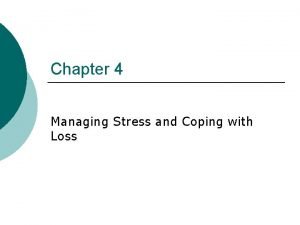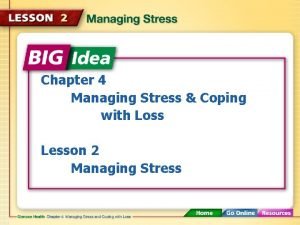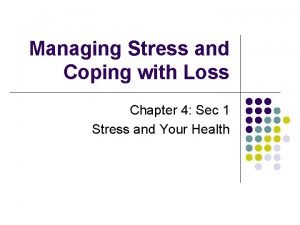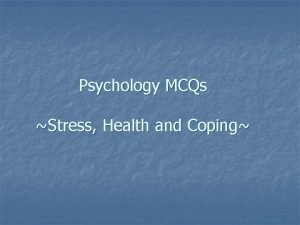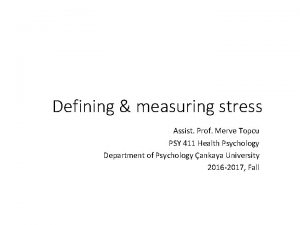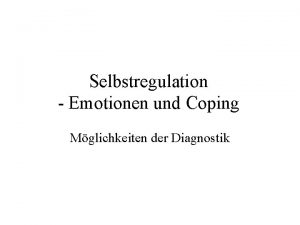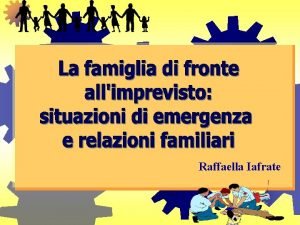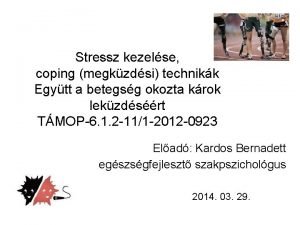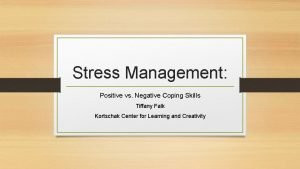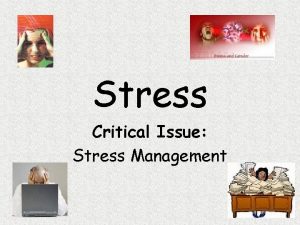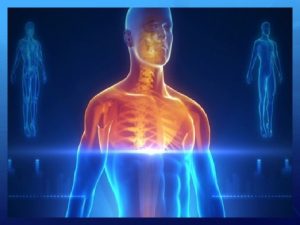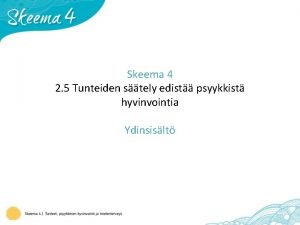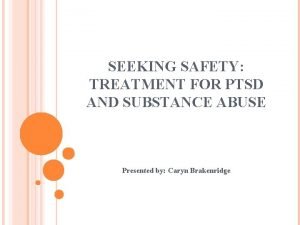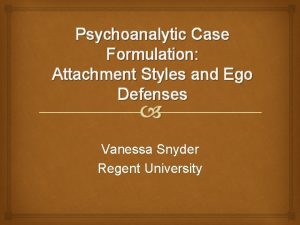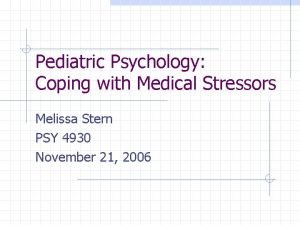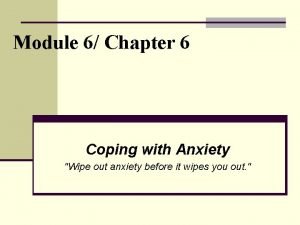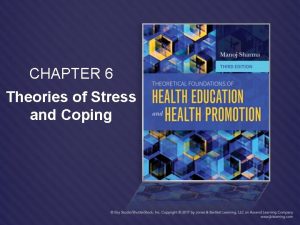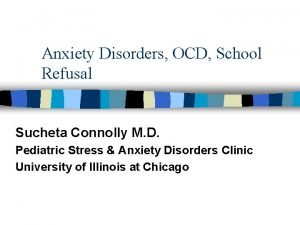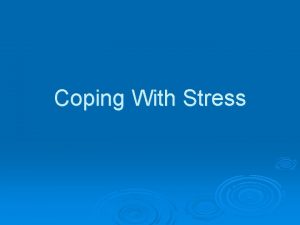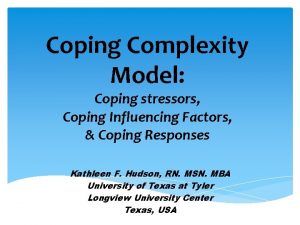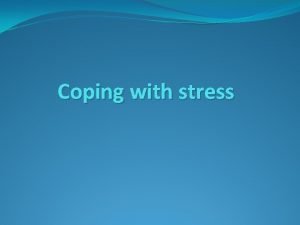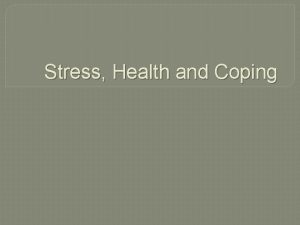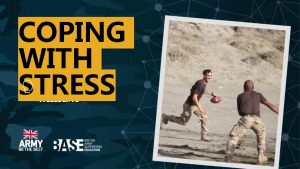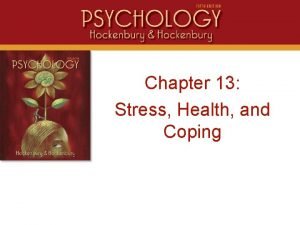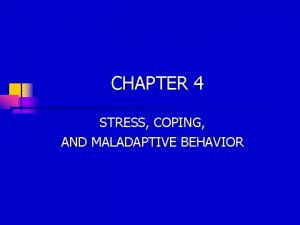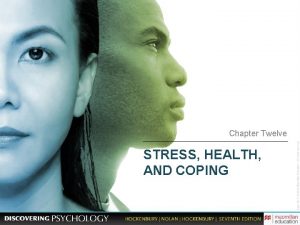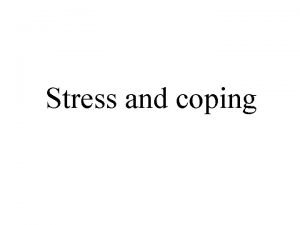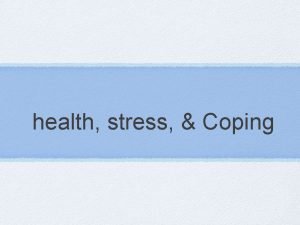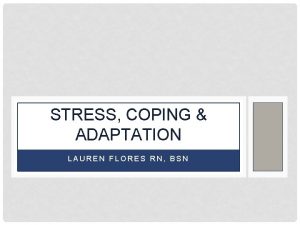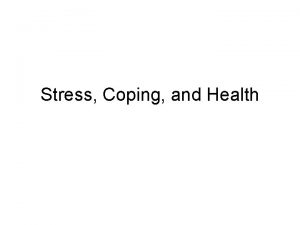CONFLICT STRESS COPING Chapter 16 1 CONFLICT CONFLICT

































- Slides: 33

CONFLICT, STRESS, & COPING Chapter 16

1. CONFLICT

CONFLICT EXAMPLES Have you ever felt conflicted over a decision? Have you ever felt like what you should do (cultural influences) are contrary to what you want to do? • Approach-approach: choice between two desirable alternatives/outcomes • Approach-avoidance: situation has both good and bad [attractive & unattractive] features • Avoidance-avoidance: choice between two unattractive alternatives/outcomes • Double approach-avoidance: choice between two alternatives that each have good and bad features

II. ANXIETY Frustration + Conflict Anxiety

ANXIETY • Anxiety is the feeling that something is wrong • Results when we can’t resolve a conflict or frustration builds too high. • Can become general feelings of being unable to cope. • Anxiety attacks = rapid heartbeat, fatigue, breathlessness, chest pain, dizziness, fainting, feeling of doom, headaches.

III. STRESS + COPING

GOOD STRESS (EUSTRESS) • ANY change, positive or negative, causes stress • Sometimes stress keeps us moving toward new goals. Stress like doing homework is good because it results in

BAD STRESS (DISTRESS) • Negative effects of stress include confusion, inability to make decisions, avoiding people, and possibly physical or psychological illness. • Deciding to make the best of a situation can limit the negative effects of stress.

FIGHT OR FLIGHT • Animals are designed to put physical safety first, and any change in the environment signals the possibility of danger. • So hearing and vision systems are designed to immediately detect any change in surroundings.

STRESS & PHYSICAL PROBLEMS • Adrenaline causes: muscles tense, heart faster, liver sends out sugar for muscles. • Body responds the same way to both physical and psychological/emotional threat. • Physical problems can result when we spend too much time running on “full alert. ”

GENERAL ADAPTATION SYNDROME • General adaptation syndrome: sequence of behavior that occurs in reaction to prolonged stress. It is divided into stages: • Alarm reaction: preparation for an attack • Body sends out emergency signals to prepare • Stage of resistance: trying to restore balance • Tries to fight back against attack • Exhaustion: giving up the battle

STRESS & CONTROL • It is important to feel in control of stressful situations. It lessens the effects of the stress. • Rats were hooked up to a wire and shocked. One had control over the shock and could stop it for both of them, but the other did not have control. Even though they received the same amount of shock, the health of the rat in charge remained good while the other’s health deteriorated. • Religion helps because the person believes there is some control somewhere on their behalf, even if it’s not them who has the control.

SELF-CONCEPT • Self-concepts: the images we have of ourselves. • Not always in line with how others see us. • Most of us see ourselves more positively than is realistic, which can help maintain a sense of wellbeing. • When important other people have an unrealistic idea of who we should be, we feel inadequate.

SELF-ESTEEM • Self-esteem: the degree to which we think we are worthwhile. • If we see ourselves as having qualities that we value, then self-esteem in higher, and vice versa. • For example, if you think it’s very important to be honest, but you tend to lie a lot, your self-esteem may suffer.

DEFENSE MECHANISMS • They help us remain psychologically stable by helping to reduce threats. • Unfortunately, that also means we are ignoring reality to some extent. • We’re usually not fully conscious of using them (they wouldn’t work if we were!) • What are some ways people ‘trick’ themselves into feeling better? • Movie examples! https: //www. youtube. com/watch? v=Fn. RBAU 6 Yg

REPRESSION & DENIAL • Repression: the process of pushing a painful event or thought out of consciousness. • Usually unhealthy. Prevents us from resolving issues. • Denial: the process of refusing to admit that there is a problem. • Common INITIAL response. Prevents us from solving a problem since we don’t admit it exists.

DISPLACEMENT & REACTION FORMATION • Displacement: the process of venting our feelings on something or someone other than the true or original target. • For example, if we are mad at our boss but can’t vent that by yelling at HIM, we might yell at a friend instead. • Reaction formation: the process of expressing the opposite of what we feel. • If a man feels hostile toward his mother, he may feel guilty for feeling that and then express care and concern toward her instead.

INTELLECTUALIZATION & IDENTIFICATION WITH THE AGGRESSOR • Intellectualization: the process of removing our feelings about an event and discussing it in a coolly rational and unemotional way. • Can be okay for a while, but the emotions do need to be dealt with eventually. • Identification with the aggressor: the process of taking on characteristics of someone who has mistreated us in order to psychologically avoid the abuse. • A prisoner of war may become like their captors, and even befriend them. This leads to confusion later on. • Kids become like their parents, doing the same things they swore they would never do.

REGRESSION & RATIONALIZATION • Regression: the process of going backward in behavior and thought to a period when we were taken care of as a child; childish behavior. • A reaction to having to be an adult and take responsibility. Usually leads to others rejecting us. • Rationalization: the process of explaining away a problem so that we don’t have to accept the blame. • Can be used to defend bad behaviors, like spending money frivolously; or can help us deal with things we have no control over, like finding faults in the person who dumped us.

PROJECTION & SUBLIMATION • Projection: the process of attributing our thoughts to someone else. • Prevents us from taking responsibility for our problems. • Sublimation: the process of channeling emotional energy into constructive or creative activities. • The only truly healthy and adaptive defense mechanism.

IV. HEALTHY CHARACTERISTICS

HEALTHY CHARACTERISTICS FOR COPING • • • Accepting yourself Accepting and being interested in others Perceiving reality accurately Feeling in control of your life Having close personal relationships Making commitments Tolerating other points of view Having a sense of purpose Being problem-centered (set and reach goals) Foreseeing problems and taking preventative action

6 STEPS TO PROBLEM SOLVING • 1. Define the problem. Definition should be workable, objective, specific, and goal oriented. Big problems can be broken down into smaller, more manageable ones. • 2. Think about different ways the problem can be approached. Be as specific as possible. • 3. Assess how workable each approach is. Trust your own judgment. • 4. Select the best approach, and come up with specifics for implementing it. • 5. Put the plan into action for a time. Put all efforts toward making it work. • 6. After a time, honestly evaluate your success. Decide to continue, make changes, or try a different plan.

V. SUBSTANCE ABUSE

SUBSTANCE ABUSE & DEPENDENCE • Substance abuse – when use of a drug interferes with work and/or relationships • Substance dependence – when physical symptoms arise from not using the drug, and a lot of time is devoted to using.

MOLECULAR STRUCTURES OF DRUGS • Drugs have molecular structures that are similar to the various chemicals already inside nerve cells, so the drug goes in, and the body listens to it because it thinks it’s a natural internal molecule. • Alcohol and tranquilizers look like the molecules that tell nerves NOT to fire. • Others look like the molecules that make the nerve cells fire. • Others like LSD make different sense circuits fire together.

ALCOHOL WITHDRAWAL • Alcohol withdrawal happens when a severe alcoholic goes without alcohol. • First symptoms are weakness, anxiety, stomach cramps. • Then come hallucinations: seeing or hearing things that are not physically present. • Confusion disorientation stupor death

SYNERGISTIC EFFECT • Liver can’t handle two different chemicals at once. • Synergistic effect: effect in which, when two drugs are taken in combination, each is more potent than it would be if it were taken by itself.

6 INDICATORS OF ALCOHOLISM • 1. frequent drinking sprees (drunkenness once a week) • 2. increase in quantity per sitting • 3. morning drinking • 4. going to school or work drunk • 5. blackouts (loss of memory) • 6. drinking whenever faced with crisis

ALCOHOL, MARIJUANA, & NICOTINE Drug Nervous System Effects Physical Effects Cognitive Effects Alcohol Depressant - Liver damage - Removes inhibitions Marijuana Depressant - Lack of coordination - Reduces male sex hormone - Confuses perception - Sleepy floaty feeling - Wipes out short term memory storage Nicotine Stimulant - Raises heart rate and blood pressure - Addiction

AMPHETAMINES, COCAINE, & OPIATES Drug Nervous System Effects Physical Effects Cognitive Effects Amphetamines Stimulant - Tolerance - Trembling - Convulsions - Feeling of excitement, freedom, energy - Bizarre mental images - Paranoia Cocaine Stimulant - Warm rush - Heart attack - Death - Opiates (heroin, morphine, opium) Sedative - Tolerance - Feel great, then crash - Dependence - Psychological dependence - Death (through additives, overdose, etc. ) Severe hallucinations Mental confusion Paranoia Psychological dependence

LSD & STEROIDS Drug Nervous System Effects Physical Effects Cognitive Effects LSD Hallucinogen - Random firing of brain cells - Hallucinations - Panic Steroids Stimulant - Body tissue damage - Heart trouble - Infertility - Loss of emotional control - Unrealistic sense of power

INTERACTIVE ELEMENTS Drugs of Abuse
 Chapter 4 managing stress and coping with loss notes
Chapter 4 managing stress and coping with loss notes Chapter 4 managing stress and coping with loss
Chapter 4 managing stress and coping with loss Chapter 4 lesson 2 managing stress answer key
Chapter 4 lesson 2 managing stress answer key Managing stress and coping with loss
Managing stress and coping with loss Stress strain coping support model
Stress strain coping support model Concept of stress and coping mcqs
Concept of stress and coping mcqs Stress appraisal and coping
Stress appraisal and coping Coping strategies for exam stress
Coping strategies for exam stress Selbstregulation
Selbstregulation Family stress and coping
Family stress and coping Chapter 10 stress responses and stress management
Chapter 10 stress responses and stress management Chapter 4 lesson 3 coping with loss and grief
Chapter 4 lesson 3 coping with loss and grief Calvin coolidge
Calvin coolidge True fracture strain
True fracture strain Definition of normal stress
Definition of normal stress Karasekin malli
Karasekin malli Lazarus megküzdés
Lazarus megküzdés Negative coping
Negative coping Problem-focused coping examples
Problem-focused coping examples Stress versus burnout
Stress versus burnout Skeema 4
Skeema 4 Seeking safety coping with triggers
Seeking safety coping with triggers Parapet cap detail
Parapet cap detail What are the ego defense mechanisms
What are the ego defense mechanisms Melissa stern psychologist
Melissa stern psychologist Nursing care for anxiety
Nursing care for anxiety Problem-focused coping examples
Problem-focused coping examples Coping disfunzionale
Coping disfunzionale What emotion affects drivers the most
What emotion affects drivers the most Problem focused coping examples
Problem focused coping examples Crisis development model directive staff approach
Crisis development model directive staff approach Constructive use of defense mechanism
Constructive use of defense mechanism Types of coping
Types of coping Coping cat fear ladder
Coping cat fear ladder

